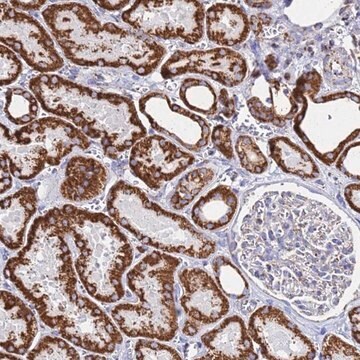推薦產品
生物源
rabbit
品質等級
共軛
unconjugated
抗體表格
affinity isolated antibody
抗體產品種類
primary antibodies
無性繁殖
polyclonal
產品線
Prestige Antibodies® Powered by Atlas Antibodies
形狀
buffered aqueous glycerol solution
物種活性
human, mouse, rat
加強驗證
orthogonal RNAseq
RNAi knockdown
Learn more about Antibody Enhanced Validation
技術
immunoblotting: 0.04-0.4 μg/mL
immunohistochemistry: 1:200-1:500
免疫原序列
ILNANYMAKRLETHYRILFRGARGYVGHEFILDTRPFKKSANIEAVDVAKRLQDYGFHAPTMSWPVAGTLMVEPTESEDKAELDRFCDAMISIRQEIADIEEGRIDPRVNPLKMSPHSLTCVTSSHWDRPYSREVAAFPLPFVKPENK
UniProt登錄號
運輸包裝
wet ice
儲存溫度
−20°C
目標翻譯後修改
unmodified
基因資訊
human ... GLDC(2731)
一般說明
GLDC (glycine decarboxylase) is a pyridoxal phosphate (PLP) containing α-amino acid decarboxylase that encodes a P-protein.
免疫原
Glycine dehydrogenase recombinant protein epitope signature tag (PrEST)
應用
All Prestige Antibodies Powered by Atlas Antibodies are developed and validated by the Human Protein Atlas (HPA) project and as a result, are supported by the most extensive characterization in the industry.
The Human Protein Atlas project can be subdivided into three efforts: Human Tissue Atlas, Cancer Atlas, and Human Cell Atlas. The antibodies that have been generated in support of the Tissue and Cancer Atlas projects have been tested by immunohistochemistry against hundreds of normal and disease tissues and through the recent efforts of the Human Cell Atlas project, many have been characterized by immunofluorescence to map the human proteome not only at the tissue level but now at the subcellular level. These images and the collection of this vast data set can be viewed on the Human Protein Atlas (HPA) site by clicking on the Image Gallery link. We also provide Prestige Antibodies® protocols and other useful information.
The Human Protein Atlas project can be subdivided into three efforts: Human Tissue Atlas, Cancer Atlas, and Human Cell Atlas. The antibodies that have been generated in support of the Tissue and Cancer Atlas projects have been tested by immunohistochemistry against hundreds of normal and disease tissues and through the recent efforts of the Human Cell Atlas project, many have been characterized by immunofluorescence to map the human proteome not only at the tissue level but now at the subcellular level. These images and the collection of this vast data set can be viewed on the Human Protein Atlas (HPA) site by clicking on the Image Gallery link. We also provide Prestige Antibodies® protocols and other useful information.
生化/生理作用
GLDC (glycine decarboxylase) has inducing effect on glycolysis and glycine/serine metabolism. This effect alters pyrimidine metabolism in regulation of cancer cell proliferation. Mutation in GLDC causes non-ketotic hyperglycinemia, also called as glycine encephalopathy. It catalyzes the glycine decarboxylation reaction by removing CO2 from the glycine substrate without releasing the expected amine group i.e. methylamine. Instead of producing methylamine as end product, the reaction ends with the generation of an aminomethyl moiety. This unusual decarboxylation mechanism produces H-protein-S-aminomethyl dihydrolipoyllysine.
特點和優勢
Prestige Antibodies® are highly characterized and extensively validated antibodies with the added benefit of all available characterization data for each target being accessible via the Human Protein Atlas portal linked just below the product name at the top of this page. The uniqueness and low cross-reactivity of the Prestige Antibodies® to other proteins are due to a thorough selection of antigen regions, affinity purification, and stringent selection. Prestige antigen controls are available for every corresponding Prestige Antibody and can be found in the linkage section.
Every Prestige Antibody is tested in the following ways:
Every Prestige Antibody is tested in the following ways:
- IHC tissue array of 44 normal human tissues and 20 of the most common cancer type tissues.
- Protein array of 364 human recombinant protein fragments.
聯結
Corresponding Antigen APREST86183
外觀
Solution in phosphate-buffered saline, pH 7.2, containing 40% glycerol and 0.02% sodium azide
法律資訊
Prestige Antibodies is a registered trademark of Merck KGaA, Darmstadt, Germany
免責聲明
Unless otherwise stated in our catalog or other company documentation accompanying the product(s), our products are intended for research use only and are not to be used for any other purpose, which includes but is not limited to, unauthorized commercial uses, in vitro diagnostic uses, ex vivo or in vivo therapeutic uses or any type of consumption or application to humans or animals.
未找到適合的產品?
試用我們的產品選擇工具.
儲存類別代碼
10 - Combustible liquids
水污染物質分類(WGK)
WGK 1
閃點(°F)
Not applicable
閃點(°C)
Not applicable
分析證明 (COA)
輸入產品批次/批號來搜索 分析證明 (COA)。在產品’s標籤上找到批次和批號,寫有 ‘Lot’或‘Batch’.。
Jennifer M Love et al.
Journal of child neurology, 29(1), 122-127 (2013-01-26)
Nonketotic hyperglycinemia is an inborn error of glycine metabolism. It manifests mostly as an acute encephalopathy in the neonatal period, although later, atypical presentations have also been reported. Mutations in 3 different genes have been implicated in nonketotic hyperglycinemia. Here
Maybelle Kho Go et al.
Biochemistry, 53(5), 947-956 (2014-01-29)
Glycine decarboxylase (GLDC) is a metabolic oncogene that links glycine metabolism with tumorigenesis. In humans, GLDC is part of a multienzyme complex (which includes the lipoyl-containing H-protein) that couples the decarboxylation of glycine to the biosynthesis of serine. Details of
Wen Cai Zhang et al.
Cell, 148(1-2), 259-272 (2012-01-10)
Identification of the factors critical to the tumor-initiating cell (TIC) state may open new avenues in cancer therapy. Here we show that the metabolic enzyme glycine decarboxylase (GLDC) is critical for TICs in non-small cell lung cancer (NSCLC). TICs from
Junko Kanno et al.
Journal of medical genetics, 44(3), e69-e69 (2007-03-16)
Non-ketotic hyperglycinaemia (NKH) is an inborn error of metabolism characterised by accumulation of glycine in body fluids and various neurological symptoms. NKH is caused by deficiency of the glycine cleavage multienzyme system with three specific components encoded by GLDC, AMT
Christiaan F Labuschagne et al.
Cell reports, 7(4), 1248-1258 (2014-05-13)
Previous work has shown that some cancer cells are highly dependent on serine/glycine uptake for proliferation. Although serine and glycine can be interconverted and either might be used for nucleotide synthesis and one-carbon metabolism, we show that exogenous glycine cannot
我們的科學家團隊在所有研究領域都有豐富的經驗,包括生命科學、材料科學、化學合成、色譜、分析等.
聯絡技術服務
